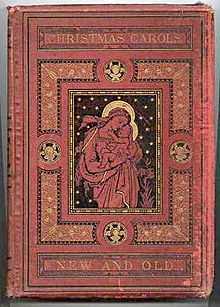Henry Ramsden Bramley

Henry Ramsden Bramley (1833–1917) was an English clergyman and hymnologist perhaps best known for his collaborations with the composer Sir John Stainer. Along with earlier 19th-century composers such as William Sandys and John Mason Neale, Bramley and Stainer are credited with fuelling a Victorian revival of Christmas carols with their 1871 publication of Christmas Carols, New and Old, which popularised carols such as "The First Nowell", "God Rest You Merry, Gentlemen" and "The Holly and the Ivy".[1]
Biography
Henry Ramsden Bramley was born at Addingham in Yorkshire. He studied at Oriel College, Oxford, and was later made a fellow of Magdalen College, Oxford, in 1857. He was ordained as a deacon in 1856, and priest in 1858. He served as Vicar of Horspath in Oxfordshire between 1861 and 1889, and was later Canon and Precentor of Lincoln Cathedral between 1895-1905.[2] Theologically, he is described in Professor Jeremy Dibble's biography of John Stainer as a "High Church conservative".[1]
Bramley became acquainted with John Stainer after the composer was appointed organist at Magdalen College in 1860. Indeed it was Bramley, as a fellow of the college, who presented Stainer with his doctoral robes.[3] In 1871, they decided to collaborate on a collection of Christmas carols called Christmas Carols, New and Old, which was revised and expanded at regular intervals over the next few years.[4] Bramley acted as the textual editor, contributing a number of new Latin translations and original verses to the publication,[1] while Stainer dealt with the music, writing a number of new arrangements.[5]
By the collection's last edition of 1878, the collection contained 70 carols.[4] Amongst these were a number of now-standard carols which the collection helped to popularise including "The First Nowell", "God Rest You Merry, Gentlemen", "The Seven Joys of Mary", "See, Amid the Winter's Snow", "Once In Royal David's City", "The Apple Wassail", "The Holly and the Ivy" and "What Child Is This?".[2][5]
William Studwell and Dorothy Jones note that the book, with an informative preface, an index with information on the origin of the carol texts and illustrations by the Brothers Dalziel caught the mood of the time, and was both "an artistic and commercial success".[3] Percy Dearmer, writing in the preface to the Oxford Book of Carols of 1928, goes further, noting that the publication was largely responsible for the 19th century Victorian revival of the Christmas carol:
"The influence of this book was enormous: it placed in the hands of the clergy...a really practicable tool, which came into general use, and is still in use after nearly sixty years. The great service done by this famous collection was that it brought thirteen traditional carols, with their proper music, into general use at once...It is…mainly to Bramley and Stainer that we owe the restoration of the carol."[6]
Studwell and Jones note that despite his numerous appointments, Christmas Carols, New and Old was Bramley's only influential publication.[3] His only other publication of any substance was his translation of The Psalter: or Psalms of David and Certain Canticles of 1884, itself based on a work by 13th century Bible translator Richard Rolle.[7] His other published works (with the exception of a few publications related to Oxford University administration) include a hymn, "The Great God of Heaven is Come Down to Earth", included in the English Hymnal of 1906, and his new translation and expansion of the Latin carol "The Cradle Song of the Blessed Virgin",[8] with music by Joseph Barnby.[3]
References
- ↑ 1.0 1.1 1.2 Jeremy Dibble, John Stainer: A Life in Music (Boydell Press, 2007), p. 118
- ↑ 2.0 2.1 Biography at the Christian Classics Ethereal Library, ccel.org
- ↑ 3.0 3.1 3.2 3.3 William Studwell, Dorothy E. Jones, Publishing Glad Tidings: Essays on Christmas music, (Routledge, 1998), p. 27-29
- ↑ 4.0 4.1 Henry Ramsden Bramley and John Stainer, Christmas Carols New and Old (London: Novello, Ewer & Co., ca 1878)
- ↑ 5.0 5.1 Bramley and Stainer at hymnsandcarolsofchristmas.com
- ↑ Dearmer, Shaw, Vaughan Williams (ed.), The Oxford Book of Carols, (Oxford University Press, 1928), pp. xvi-xvii.
- ↑ Henry Ramsden Bramley, The Psalter: or Psalms of David and certain canticles (Clarendon press, 1884)
- ↑ In Latin "Dormi Jesu, mater ridet"; the former English translation, by Samuel Taylor Coleridge, was published in 1817.
External links
- Facsimile of Christmas Carols New and Old at Christian Classics Ethereal Library
|